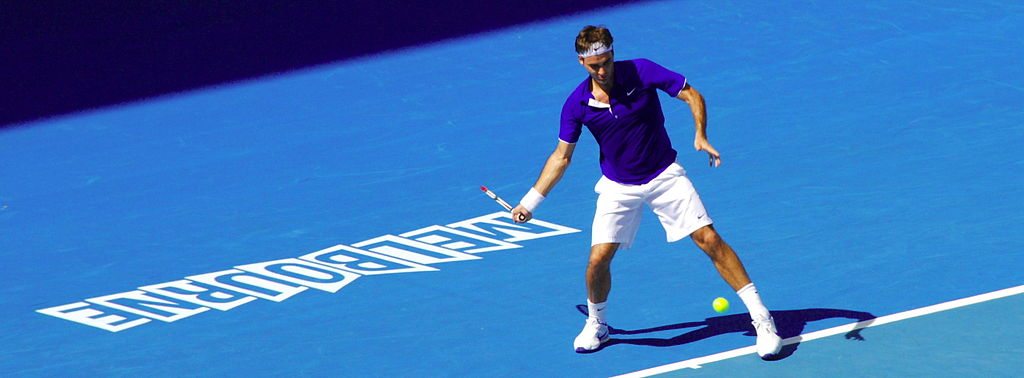Tennis legends roll back the years in Melbourne
Ahead of the 2017 Australian Open men’s singles the focus was on the return of two legends: Roger Federer and Rafael Nadal. Nadal returned to tennis after an injury-strewn 2016 season, which he ended in October to prepare for 2017. Federer injured his left knee just after the 2016 Australian Open and continued to suffer from back and knee troubles. Despite this, world number one Andy Murray and six-time champion Novak Djokovic were clear favourites to win the tournament. On the women’s side, the top two seeds Angelique Kerber and Serena Williams were favourites, despite a talented field including Agnieszka Radwanska, Garbine Muguruza and Johanna Konta.
The first week of the tournament was more unpredictable than any major in recent history. The second round saw the first and biggest shock of the tournament: second seed Djokovic’s elimination by Uzbek wildcard Denis Istomin in a five-set classic. Radwanska was also upset in straight sets by thirty-four-year-old Croatian Lučić-Baroni – Radwanska’s earliest exit at the Australian Open since 2009.
Djokovic’s loss guaranteed Murray the number one ranking until May at the very least. However, his goal of finally winning an Australian Open title after falling in the final five times was ended in the fourth round by German veteran Mischa Zverev, whose serve and volley tennis overwhelmed Murray on this year’s quicker court surfaces. On the same day Kerber, the women’s world number one, was upset by American Coco Vanderweigh in two sets – the first time both number ones were eliminated on the same day since Wimbledon 2014.
It was the first time since 1968 that all four finalists were aged over thirty, owning a combined tally of sixty majors between them.
The early upsets in the men’s singles opened the draw for thirty-five-year-old Federer, who was slated to face Murray in the quarter final. After two rusty wins in the first two rounds, the now seventeenth ranked Federer took apart Czech Tomas Berdych. He then beat fifth seed Nishikori in a five-set classic to reach the quarter finals and record his 200th win against top ten opponents. Similarly, Nadal avoided an upset in the second round against talented German teenager Alex Zverev and breezed past two more opponents to set up a quarterfinal against big serving third seed Milos Raonic.
Stanislas Wawrinka and Grigor Dimitrov progressed to the last four relatively under the radar. Nadal was clinical in defeating third seed Milos Raonic in straight sets, advancing to his 50th slam semi-final, while Federer dismantled Murray’s conquerer Zverev 6-1, 7-5, 6-2 to reach the final four.
Lučić-Baroni backed up her upset of Radwanska with three wins, including beating fifth seed Karolína Plíšková in the quarterfinals to surge to the tournament’s penultimate round. Meanwhile, Williams ended Brit Konta’s quarter-final run to set up a semi-final with Lučić-Baroni. Her older sister Venus flowed impressively in her quarter final to set up a semi-final meeting with Vandeweghe, who beat the talented Spaniard Garbine Muguruza.
Serena continued her march to the final by beating Lučić-Baroni, who she last met in 1998. Her sister Venus beat Vanderweigh in three sets to set up a mouth-watering final between the two sisters. The men’s semi-finals were even more intriguing. The first was a Swiss affair between Wawrinka and a resurgent Federer. Federer, playing vintage tennis, took the first two sets, before Wawrinka hit back to take the next two, extending the match to a final set shoot-out. The match was decided by one loose game from Wawrinka, which Federer capitalised on, taking the final set 6-3. The second semi-final saw Nadal face an in-from Dimitrov. The match took five sets and five hours, but the ever-defiant Rafa won the attritional battle to set up a delectable final with arch-rival Federer, the first time the two had met in a grand slam final since the 2011 French Open.
Federer and Nadal’s rivalry peaked in the famous final of Wimbledon in 2008, which is widely regarded as the greatest match ever played.
It was the first time since 1968 that all four finalists were aged over thirty, owning a combined tally of sixty majors between them. Leading the pack was Serena, gunning for her twenty third trophy. Her powerful game proved too much for her legendary sister, winning in straight-sets to claim her seventh Australian open, strengthening her claim to being the greatest ever tennis player.
Federer and Nadal’s rivalry peaked in the famous final of Wimbledon in 2008, which is widely regarded as the greatest match ever played. Former world number one Andy Roddick predicted that should the two get to the final, it may be the most important match in grand-slam history, as a victory for Federer would put him far ahead of the pack with eighteen slam titles. A win for Nadal would narrow the gap between him and Federer to just two grand slams, giving him the chance to equal or surpass the Swiss.
The final lived up to the hype. Federer took the first and third sets, with Nadal hitting back, taking the second and fourth sets. The fifth set started with Nadal breaking Federer, and seemingly about to win the title. Yet Federer hit back, taking the last five games to claim his eighteenth grand slam title – wrapping up a memorable tournament to become the second oldest grand slam champion in history.

Comments (1)
What’s up, its nice paragraph concerning media print, we all know media is a
impressive source of facts.